In the Warden’s Lodgings
In the 17th century, as for centuries both before and after, marriage was often the only way for a woman to secure both her social position and her future financial well-being. Margaret Smith had already been widowed twice, borne six children and lost four of them in their infancy by the time she married Henry Savile (Warden of Merton 1585-1622) in 1591 or 1592, so can have been under no illusions as to the realities and dangers of marriage. The daughter of George Dacres of Cheshunt, Hertfordshire, she had first married George Garrard, or Gerrard, son of a former Lord Mayor of London. Of their three daughters, the eldest, Anne, married a viscount, and the third, Frances, married a knight, so by this first marriage she had already fulfilled the role of producing legitimate issue who made good marriages. Her second marriage, to John Smith, esquire, produced three sons, all of whom died young.
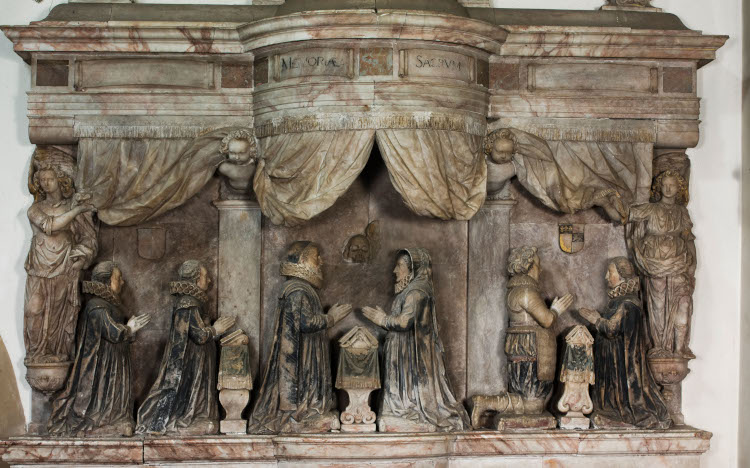
Photo: © Alamy
Margaret Smith married Henry Savile (knighted in September 1604) in 1591 or 1592 and would have occupied the Warden’s Lodgings at Merton until her husband was appointed Provost of Eton in 1595: a position he held concurrently with the wardenship of Merton until his death. Thereafter, Henry Savile preferred to reside at Eton for most of the year, so it was only natural that his wife would have joined him there. She bore him three children: two sons who both died young, and a daughter Elizabeth who survived and subsequently married Sir John Sedley, baronet.
Her husband was a man of remarkable academic abilities, but was not noted for his tact or patience with those whose abilities he doubted. John Aubrey recorded that at Eton Savile was regarded as “a very severe Governour, the scholars hated him for his austerity”. While at Merton, one of the fellows, aggrieved by Savile’s management of the College, maintained that he was, “too much inflated with his learning and riches” and “did oppress the fellows grievously”.
Margaret Savile herself may have experienced something of the same, although one report is of her complaining rather of neglect while her husband gave preference to his studies. “Sir Henry, I would that I were a book, and then you would a little more respect me.” A bystander, if not Henry Savile himself, is reported as having replied, “Madam, you ought to be an almanac, that he might change at the year’s end.” Following her husband’s death in 1622, Lady Savile went to live with her second daughter Lady Frances Harrison in Hurst, Berkshire. There she lived for the last nine years of her life, and where she was buried in 1631 in the place where, according to her monument, “liveinge she had found soe much content & soe sweet a repose of her age”.
Anyone familiar with the work of Jane Austen, whether book, television drama or film adaptation, will know the limited opportunities open to women of the gentle classes in the 18th century. A good, or at least sufficient, marriage; service as a governess or lady’s companion; or as a dependent on or within one’s own family. Anne Wyntle’s life took her down the latter path, living with her unmarried brother Robert (Warden 1734-50) in the Lodgings where, presumably, she acted as his companion, hostess and keeper of his household.
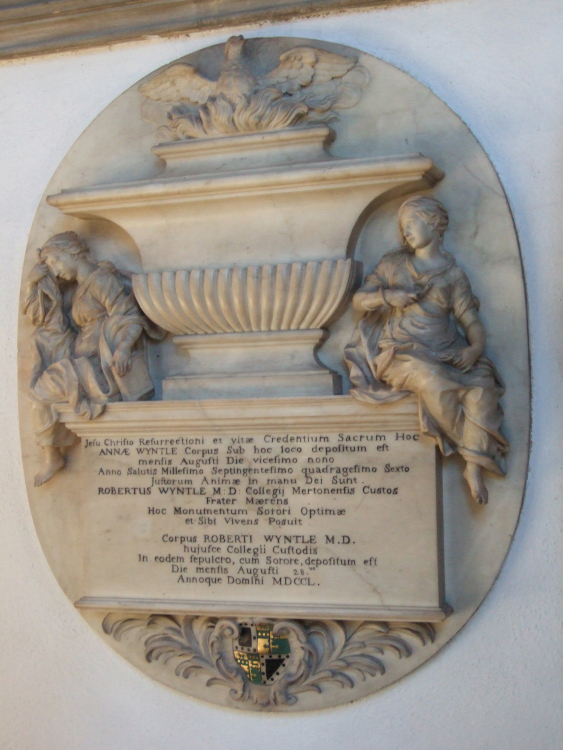
We know next to nothing of her life, not even the year of her birth, although she was most likely born in Gloucester, where her brother was born in 1683. She died in August 1746 and was buried in the north transept of the chapel, her life marked by a monument on the west wall, among the most sensitive in the chapel. Her defining characteristic: that she was “the best of sisters” (sorori optimae). The registration of her burial was overlooked at the time and was only inserted later into the register, between the entries for Jane Sherwood in 1745 and that of her brother Robert in August 1750.
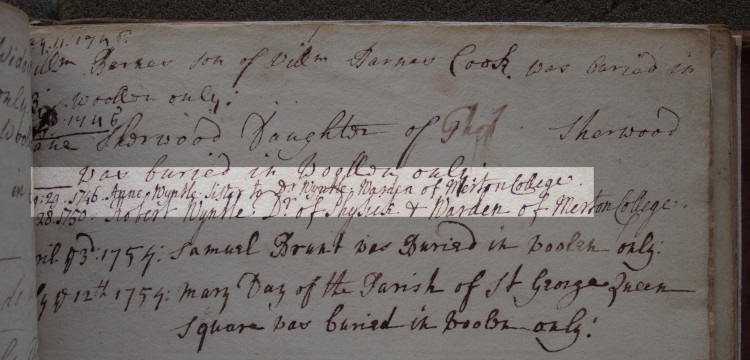
Almeria Selina Vaughan was the only daughter in a family of seven children and her life exemplified what might happen to a young woman of the ‘respectable’ classes of her generation. Her father, James Vaughan, was a member of the Royal College of Physicians practicing in Leicester. All his sons were first educated at Rugby, before progressing either to Oxford or Cambridge. The eldest, James, died aged just 22. The next son, Henry, trained as a doctor, served as a royal physician, and as President of the Royal College of Physicians for 24 years. He later inherited family estates at Wistow, Leicestershire, which he enjoyed as Sir Henry Halford, baronet. The third brother, John, qualified as a barrister, was knighted by George IV, and served as a privy councillor to William IV. Fourth brother, Charles, attended Merton before being elected fellow of All Souls College, Oxford, and serving as a diplomat in various European capitals. In 1825 he was made minister-plenipotentiary to the United States. Fifth brother, Peter, also attended Merton, where he was elected Warden in 1810; from 1820 he also held the office of Dean of Chester. The youngest brother, Edward, attended Trinity College, Cambridge, before being ordained to the ministry.
In contrast, we know nothing of the upbringing and education of Almeria Vaughan. Unlike her brothers, she is not mentioned in the entry for her father in the biographical register of its members maintained by the Royal College of Physicians. Her mother had died in 1791 and it might have been upon the death of her father in 1813 that she came to Merton to live with her brother Peter. Although unmarried, by 1814 Warden Vaughan appears to have entered into a relationship with a woman whom his younger brother Edward was later to epitomize as his ‘concubine’ and an ‘abominable connection’. It may have been to escape these irregular domestic arrangements that Almeria Vaughan decided to marry: to Dr David Hughes, Principal of Jesus College. She was 45 and he was then in his 60s. They were married in Merton College chapel on 23 December 1816. The marriage was not to last long. In March 1817, Dr Hughes travelled up to London where, on the 7th, he visited his favourite coffee house in Mayfair and shot himself.
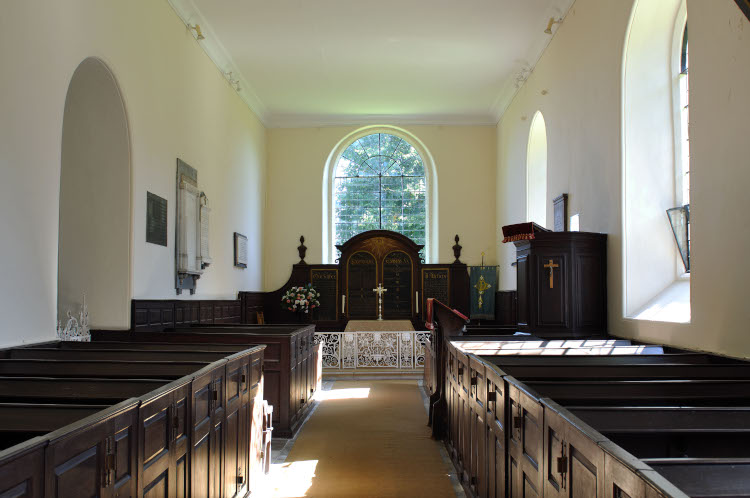
Photo: © Alamy
Almeria Hughes never remarried. We do not know for certain how she spent the remaining twenty years of her life, but it is possible that she became a widowed dependent in the household of her brother the baronet. At least, it was at Wistow that she died in 1837, and where she was buried near the altar of the parish church with other members of her family.
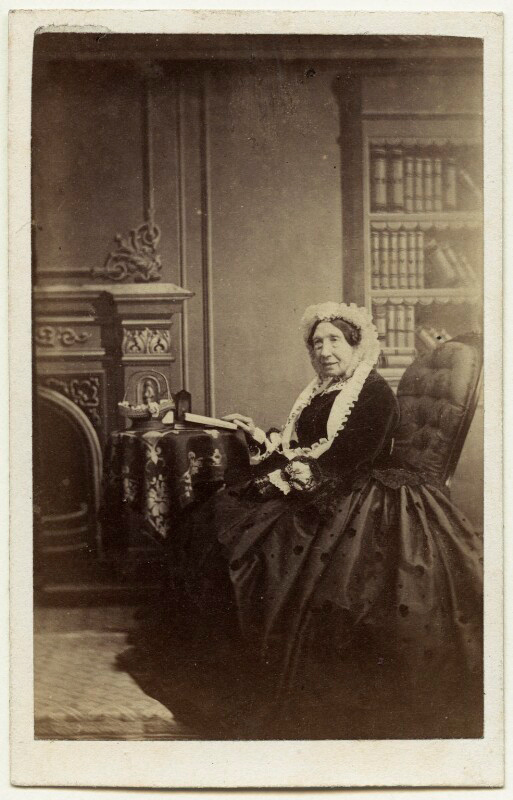
Image: © National Portrait Gallery, London [CC BY-NC-ND]
Janet Carmichael Anstruther married Robert Marsham, Warden of Merton 1826-80, in March 1828. The daughter of Major-General David Dewar of Fife, she was a widow, having married Sir John Carmichael Anstruther, baronet, in January 1817. He died just 12 months later, leaving her expecting their yet-to-be-born son, who was born six days later and named John after his father. Lady Carmichael Anstruther, as she continued to be known, bore Robert Marsham five children: two girls and three boys, all baptized in the college chapel. In addition, during the early years of her marriage the Warden’s Lodgings also provided a home for her widowed mother, Mary Dewar, and her unmarried sister Ann.
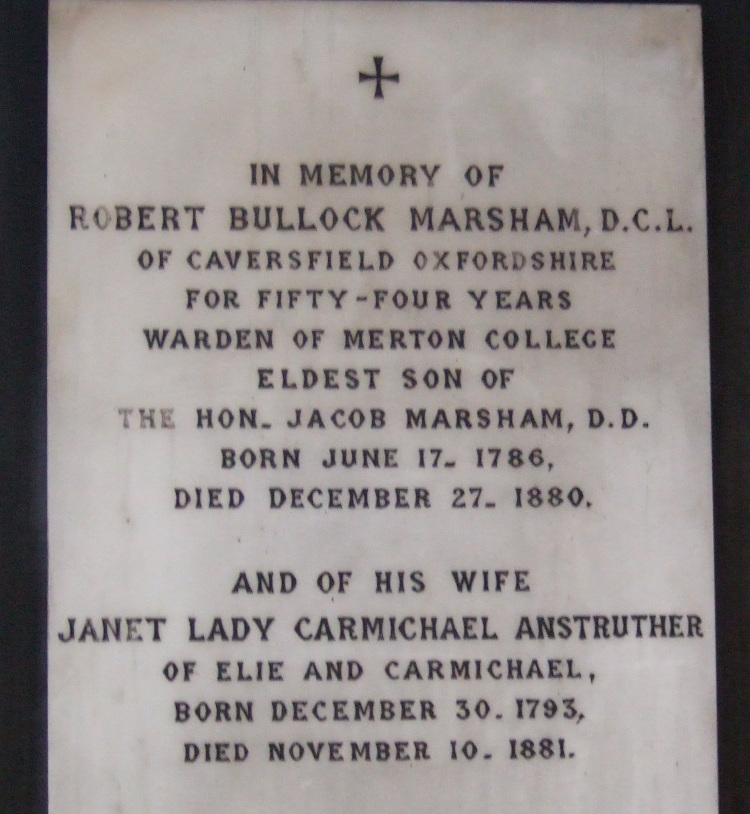
Lady Carmichael Anstruther knew further tragedy when her eldest son died following an accident while a pupil at Eton, in 1831, aged just 13. It may have come as some relief when her husband inherited his father’s large house in Caversfield, north Oxfordshire, when she was able to remove her household from Oxford. She died at Caversfield 10 November 1881, having survived her second husband by 11 months. She was buried in the north transept of the college chapel, near the graves of her husband, her mother, her sister and her eldest son.